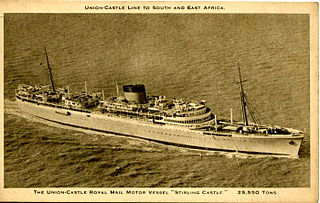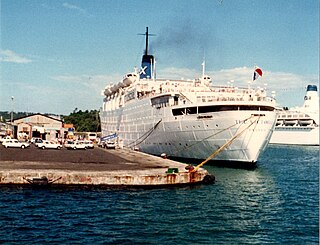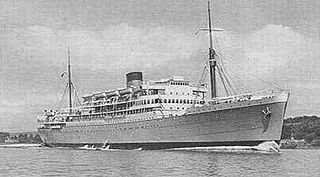
RMMV Stirling Castle was a British ocean liner of the Union-Castle Line built by Harland & Wolff in Belfast for the Southampton to South Africa mail service. She was launched on 15 August 1935 and was the first of two identical sister ships, being joined a few months later by the Athlone Castle.

RMS Windsor Castle was a passenger and cargo liner operated by the Union-Castle Line on its Cape Mail service between Britain and South Africa. Completed in 1960, she was the line’s largest Royal Mail Ship on that route.

RMS Transvaal Castle was a British ocean liner built by John Brown & Company at Clydebank for the Union-Castle Line for their mail service between Southampton and Durban. In 1966 she was sold to the South Africa-based Safmarine and renamed S.A. Vaal for further service on the same route. Following cessation of the service between the UK and South Africa in 1977 the ship was sold to Carnival Cruise Line and rebuilt in Japan as the cruise ship SS Festivale, re-entering service in 1978. In 1996 she was chartered to Dolphin Cruise Line and renamed IslandBreeze. In 1998 the ship was sold to Premier Cruise Line, which renamed her The Big Red Boat III. Following the bankruptcy of Premier Cruise Line in 2000, The Big Red Boat III was laid up until 2003 when she was sold to scrappers in Alang, India. She was renamed The Big Red Boat for her final voyage to the scrapyard.

MS Dunnottar Castle was a British-built passenger ship with a career of more than six decades that included periods as an ocean liner, an armed merchant cruiser (AMC), a troop ship and several decades as a cruise ship. As a cruise ship she was renamed Victoria, then The Victoria and finally Princesa Victoria.

SS Akaroa was a UK steam ocean liner and refrigerated cargo ship. She was launched in 1914 in Ireland as Euripides for Aberdeen Line. When new, she was the largest ship in the Aberdeen Line fleet.

RMS Arundel Castle was a British ocean liner and Royal Mail Ship which entered service in 1921 for the Union-Castle Line. A previous vessel of the same name was built in 1864 by Donald Currie & Co. and sold in 1883, whereupon it was renamed Chittagong. Originally laid down as the Amroth Castle in 1915, building was delayed by the First World War. She was eventually launched on 11 September 1919. She was completed on 8 April 1921 and in 22 April 1921 the ship departed from Southampton on her maiden voyage to Cape Town. During World War 2 she was requisitioned by the Admiralty to serve as a troopship. After the war she resumed passenger service, eventually being scrapped in 1959.

RMMV Capetown Castle was a British passenger liner built by Harland & Wolff at Belfast for the Union-Castle Line's mail service from Southampton to South Africa. She was launched in September 1937 and sailed on her maiden voyage on 29 April 1938.

SS Minnedosa was one of a pair of transatlantic steam ocean liners that were built in the United Kingdom, launched in 1917 and operated by Canadian Pacific until 1935. Her sister ship was Melita.

SS Ionic was a steam-powered ocean liner built in 1902 by Harland and Wolff in Belfast for the White Star Line. She was the second White Star Liner to be named Ionic and served on the United Kingdom – New Zealand route. Her sister ships were SS Athenic and SS Corinthic.

The SS Chusan was a British ocean liner and cruise ship, built for the Peninsular and Oriental Steam Navigation Company's Indian and Far East Service in 1950. She was named after Chusan, a small island off China. A smaller version of the SS Himalaya, the Chusan had a gross register tonnage of 24,215; and a capacity of 1,565 passengers and crew. She was built as a replacement for the RMS Viceroy of India, lost in the Second World War. She was 646.5 feet (197.1 m) long. The Chusan is said to have brought new standards of shipboard luxury to India and the Far East. She was the last passenger liner built for P & O by Vickers-Armstrongs.

SS Lapland was a steam ocean liner built in Ireland for the Belgian Red Star Line, as Red Star's flagship, similar in appearance to the fellow liners SS Samland, SS Gothland and SS Poland, but far larger. She was a half sister to White Star Line's "Big Four." They were similar in many ways, such as the island bridge, 4 masts, 2 funnels. But Lapland had a less luxurious interior.

RMS Pendennis Castle was a Royal Mail Ship, passenger and cargo liner operated by the Union-Castle Line. The vessel served the Union-Castle Line from 1959-1976 on a regular route between the UK and South Africa for the Southampton to Las Palmas, Cape Town, Port Elizabeth, East London and Durban "Cape Mail" service. After her withdrawal from service and subsequent sale by the Union-Castle Line in 1976, she was re-named consecutively Ocean Queen, Sinbad, then Sinbad I, however she never returned to commercial service after her Union-Castle Line service and was sold for scrap in 1980.

SS Themistocles was a UK steam ocean liner and refrigerated cargo ship. She was launched in 1910 in Ireland and scrapped in 1947 in Scotland. She was built for Aberdeen Line, White Star Line managed her for a few years, and she spent the latter part of her career with Shaw, Savill & Albion Line.

MV Carnarvon Castle was an ocean liner of the Union-Castle Line. She was requisitioned for service as an auxiliary cruiser by the Royal Navy during the Second World War.

SS Westernland was a transatlantic ocean liner that was launched as Regina in Scotland in 1917, renamed Westernland in 1929 and was scrapped in 1947. She began her career as a troop ship repatriating US troops after the Armistice of 11 November 1918. In the Second World War, Westernland served as a troop ship, repair ship and destroyer depot ship.
RMS Andes was a 26,689 GRT steam turbine Royal Mail Ship, ocean liner, cruise ship, and the flagship of the Royal Mail Lines fleet. She was the second Royal Mail ship to be named after the South American Andes mountain range. The first RMS Andes was an A-class liner launched in 1913. In 1929 that RMS Andes was converted into a cruise ship and renamed Atlantis.

The Jubilee class were a group of five passenger and cargo ocean liners built by Harland and Wolff at Belfast, for the White Star Line, specifically for the White Star Line's service from the UK to Australia on the Liverpool–Cape Town–Sydney route. The five ships in order of the dates they entered service were:

HMS Dunvegan Castle was a UK ocean liner that was converted into an armed merchant cruiser (AMC) in the Second World War. Harland and Wolff built her and her sister ship Dunnottar Castle in Belfast in 1936.

SS Stratheden was a UK-built steam turbine ocean liner. She spent most of her career with the Peninsular and Oriental Steam Navigation Company, including the Second World War when she served for six years as a troop ship.
SS Melita was one of a pair of transatlantic steam ocean liners that were built in the United Kingdom, launched in 1917 and operated by Canadian Pacific until 1935. Her sister ship was Minnedosa.




















